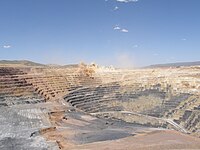
Photo from wikipedia
Soil construction and revegetation are essential for ecological restoration in mining areas. The influence of vegetation on the horizontal and vertical distribution patterns of soil properties should be fully understood.… Click to show full abstract
Soil construction and revegetation are essential for ecological restoration in mining areas. The influence of vegetation on the horizontal and vertical distribution patterns of soil properties should be fully understood. However, most studies on reconstructed soils in mining areas only concentrate on the surface soil, without exploring the vertical variations in soil properties. Overall, this study aims to explore the potential mechanisms by which surface vegetation exerts some influence on the spatial distribution of soil physicochemical properties, and to provide some insight into revegetation and soil reclamation in mining areas. Descriptive statistics and one-way analysis of variance (one-way ANOVA) were employed to evaluate the differences in the soil physicochemical properties in horizontal and vertical directions under different land-use types in the south dump of Antaibao opencast mine in Pingshuo, Shanxi Province, China. The main results of this study are as follows: (1) In the horizontal direction, except for the strong variation (variation coefficient ≥ 100%) in soil organic matter (SOM) content at some depths, the degree of variation in other soil physicochemical properties at various depths was moderate or weak (variation coefficient < 100%). The soil physicochemical properties gradually remained constant after years of reclamation. In the vertical direction, the soil bulk density (SBD), soil porosity, SOM content, soil C/N ratio, soil total nitrogen (STN) content, soil available phosphorus (SAP) content, and soil available potassium (SAK) content showed significant variations (p < 0.05) between soil depths. In contrast, no significant difference was found for other physicochemical properties. (2) The SBD, STN, SAK, soil porosity, and soil clay content were significantly different (p < 0.05) under different vegetation cover types, but the influence of vegetation on other soil physicochemical properties seemed to be limited. The results reveal that trees have a stronger ability to reduce soil grain sizes and enhance SAP contents than shrubs or herbs; however, the beneficial effects of herbs on the physicochemical properties of shallow soil are more obvious than those of trees and shrubs. (3) This study indicates that more shrubs and trees should be planted in the areas with low vegetation coverage, and more measures should be taken to improve soil physicochemical properties in order to prevent the occurrence of large-scale degradation. The reconstruction of soil structure should be preferentially considered in the process of soil reconstruction and revegetation in areas under similar conditions. Herbs should first be planted in the early reclamation stage. At the same time, shrubs or trees can be adopted in the middle and late stages of vegetation reconstruction in order to achieve comprehensive revegetation.
Journal Title: International Journal of Environmental Research and Public Health
Year Published: 2022
Link to full text (if available)
Share on Social Media: Sign Up to like & get
recommendations!